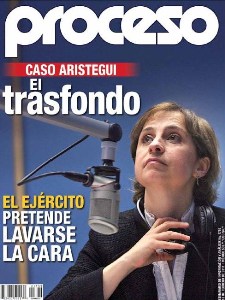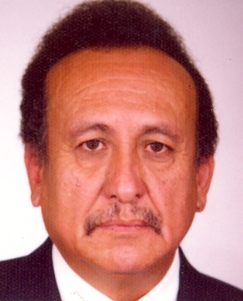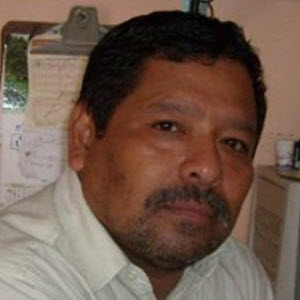
Proceso is a left-wing Mexican news magazine published in Mexico City. It was founded in 1976 by journalist Julio Scherer García, who additionally served as its president until his death in 2015. Proceso was traditionally renowned for its left-wing journalism.
Human rights in Mexico refers to moral principles or norms that describe certain standards of human behaviour in Mexico, and are regularly protected as legal rights in municipal and international law. The problems include torture, extrajudicial killings and summary executions, police repression, sexual murder, and, more recently, news reporter assassinations.

San Fernando is a city located in the Mexican state of Tamaulipas; it serves as the seat of the surrounding municipality of the same name. It is about 85 miles (137 km) away from Brownsville, Texas, United States. The municipality has a population of 57,220, while the city itself has a population of 29,665.
The 2010 San Fernando massacre, also known as the first massacre of San Fernando, was the mass murder of 72 undocumented immigrants by the Los Zetas drug cartel in the village of El Huizachal in the municipality of San Fernando, Tamaulipas, Mexico. The 72 killed—58 men and 14 women—were mainly from Central and South America, and they were shot in the back of the head and then piled up together. The bodies were found inside a ranch on 24 August 2010 by the Mexican military after they engaged in an armed confrontation with members of a drug cartel. They received information of the place after one of the three survivors survived a shot to the neck and face, faked his death, and then fled to a military checkpoint to seek help. Investigators later mentioned that the massacre was a result of the immigrants' refusal to work for Los Zetas, or to provide money for their release.
The 2011 San Fernando massacre, also known as the second massacre of San Fernando, was the mass murder of 193 people by Los Zetas drug cartel at La Joya ranch in the municipality of San Fernando, Tamaulipas, Mexico, in March 2011. Authorities investigating the massacre reported numerous hijackings of passenger buses on Mexican Federal Highway 101 in San Fernando, and the kidnapped victims were later killed and buried in 47 clandestine mass graves. The investigations began immediately after several suitcases and other baggage went unclaimed in Reynosa and Matamoros, Tamaulipas. On 6 April 2011, Mexican authorities exhumed 59 corpses from eight mass graves. By 7 June 2011, after a series of multiple excavations, a total of 193 bodies were exhumed from mass graves in San Fernando.

Javier Valdez Cárdenas was a Mexican journalist and founder of Ríodoce, a newspaper based in Sinaloa. He received several international awards for his writings on drug trafficking and organized crime in the Mexican Drug War.

José Antonio García Apac, also known as "El Chino", was a Mexican journalist and editor for the Ecos de la Cuenca in Tepalcatepec, Michoacán, Mexico, when he disappeared 20 November 2006. He is best known for the news stories he published on the violent relationship between the drug cartels in his home state and its authorities.

Regina Martínez Pérez was a Mexican journalist and veteran crime reporter for Proceso, a center-left Mexican news magazine known for its critical reporting of the social and political establishment.
Raúl Gibb Guerrero was a Mexican editor and the founder and owner of the newspaper La Opinión in Poza Rica, Veracruz, Mexico. Gibb was murdered in Veracruz and was awarded "2005-2006 International Editors of the Year" by WorldPress.org. His newspaper had already won awards for his coverage of corruption.
Disappearance of Zane Plemmons, a Mexican-American photojournalist who does freelance work for the Sinaloa newspaper El Debate, occurred on 21 May 2012 in Nuevo Laredo, Tamaulipas, Mexico after covering a shootout.

On 13 August 2012, Mario Segura, a Mexican journalist who served as an editor for El Sol del Sur Tampico, a regional newspaper in Tampico, Tamaulipas, was abducted by a drug cartel. He was released a week later and was forced to relocate with his family to Mexico City, where he became a clown as he could no longer get a job as a journalist. Mario Segura is one of at least 30 Mexican journalists who have had to relocate because of threats and violence.

Dolores Guadalupe García Escamilla was a Mexican crime reporter and anchorwoman for Punto Rojo, a radio show on XHNOE-FM radio based in Nuevo Laredo, Tamaulipas, Mexico. She had experience in a number of news platforms and was a radio personality and crime reporter since 2001.

Mariana Atencio is an American journalist, television host, author and speaker who was formerly a correspondent for NBC News. Atencio is a native of Venezuela and holds a master's degree from the Columbia University Graduate School of Journalism. In 2020, Atencio cofounded GoLike, a multimedia production company.

Cristián Alberto López Bello was a crime journalist for the Mexican newspaper El Imparcial and the radio show "Foro Político", in Oaxaca, Mexico. The murder of López was an early case that tested the new powers of federal special prosecutors to investigate crimes against Mexican journalists and freedom of expression. The federal special prosecutor, however, deferred to the Attorney General of Oaxaca, who said three and a half months after the López murder that the motive was a bar fight, announced the arrest of four people, and then resigned the next day. The family publicly disagreed with the official conclusion.
This is a list of events that happened in 2014 in Mexico. The article also lists the most important political leaders during the year at both federal and state levels.
Gregorio Jiménez de la Cruz was a Mexican journalist and photographer. He was murdered in February 2014 in Veracruz, which has been described as the most dangerous state for journalists in Mexico. He was at least the tenth journalist killed in Veracruz since Javier Duarte became governor 38 months earlier. At the time of Jiménez's murder, four additional journalists were missing in the state.

Rubén Manuel Espinosa Becerril was a Mexican self-taught photographer and journalist. He worked for AVC News agency and Proceso and Cuartoscuro magazines. He covered daily news and social protests. He documented several protests where individuals were assaulted. Espinosa was killed in Narvate, Mexico City, Mexico along with four women.

Miroslava Breach Velducea was a Mexican investigative journalist for La Jornada and Norte de Juárez in Chihuahua City, Mexico known for her reportage of human rights violations, drug trafficking, and government corruption. She was murdered on 23 March 2017 as she was leaving her home. She was one of six journalists killed in Mexico in 2017.
Aleida Quintana Ordaz is a Mexican human rights activist trained as a social anthropologist. She was exiled to Spain due to the threats she experienced because of her activism.











